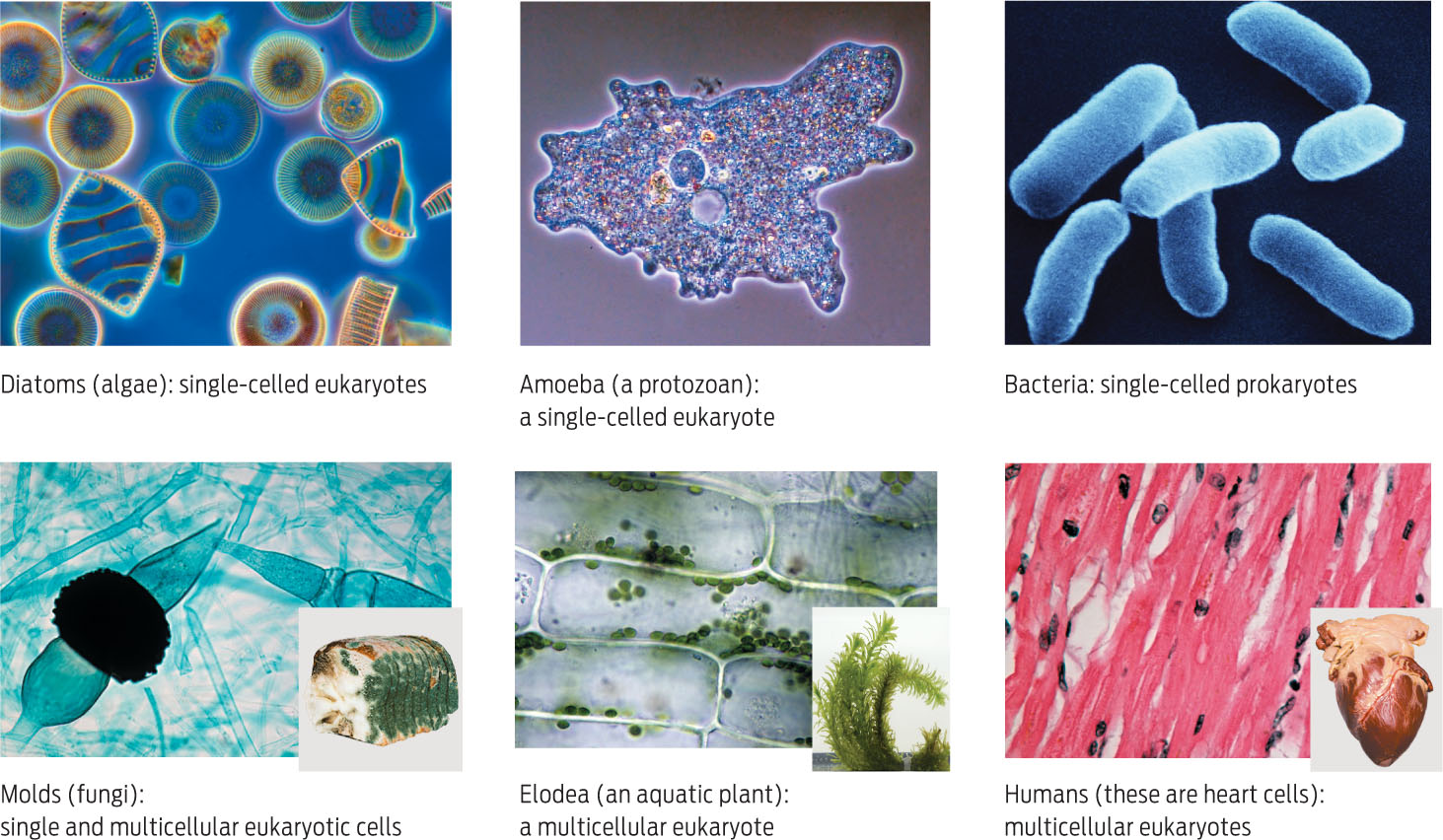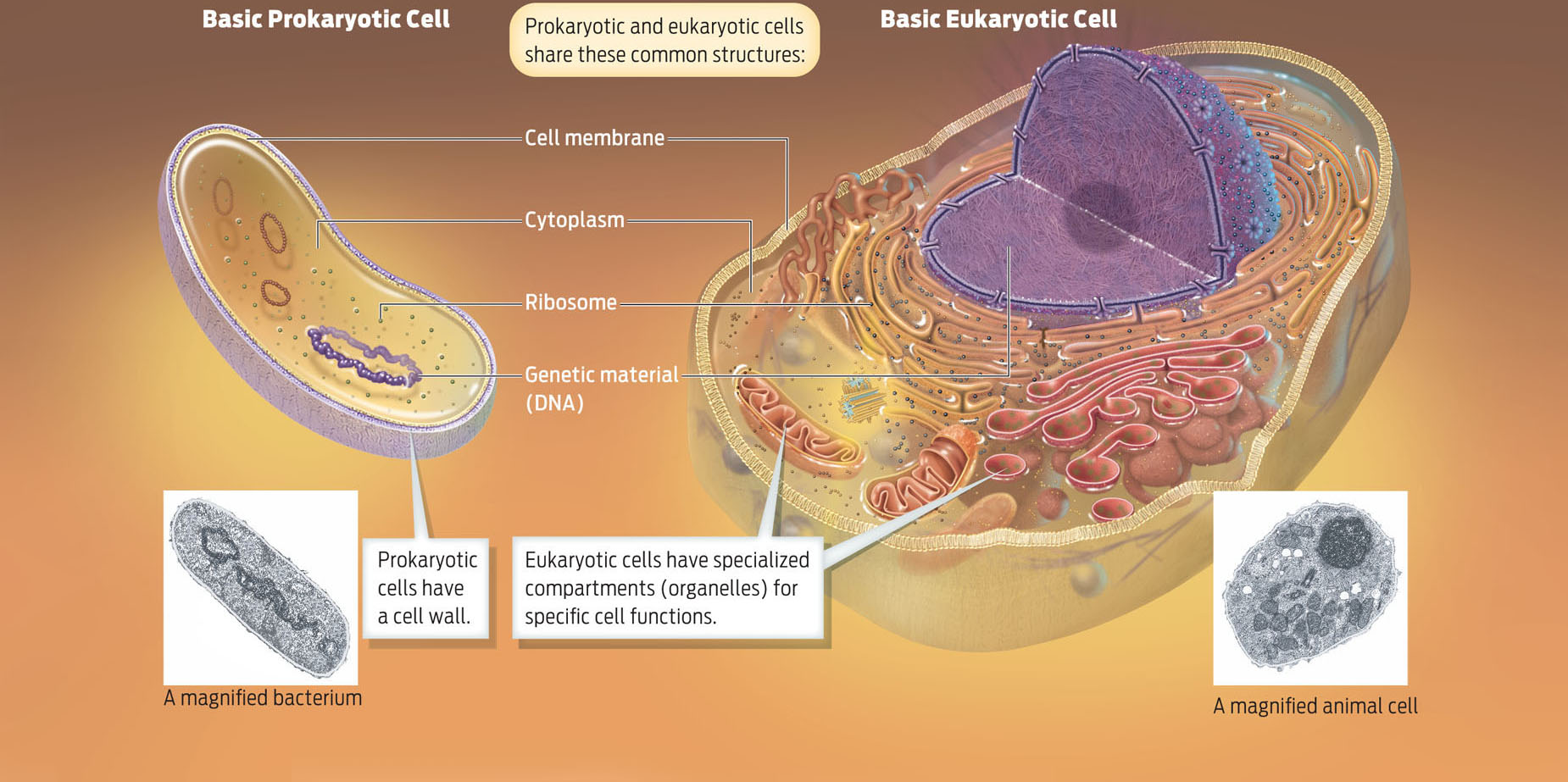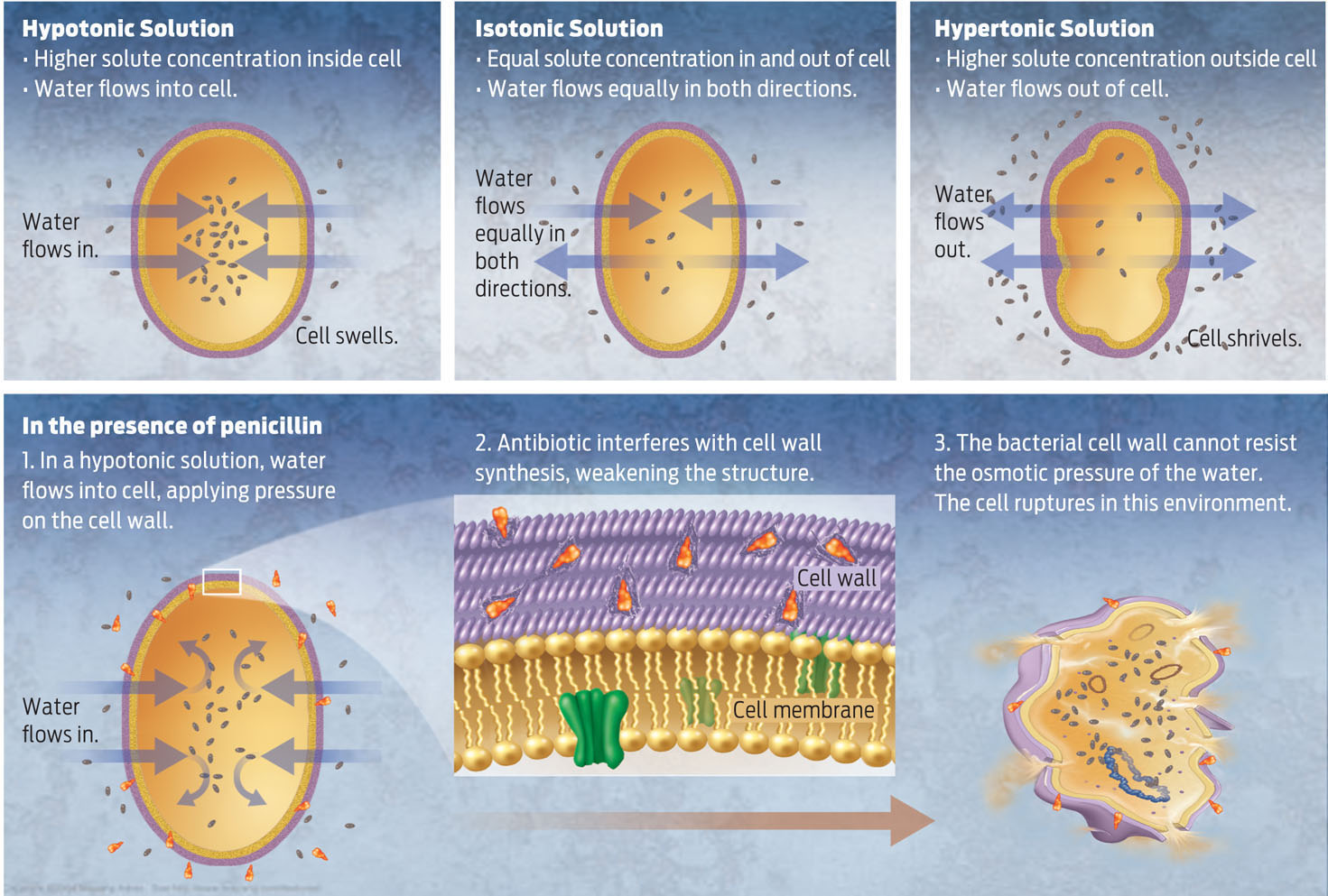BUG BULLET
What makes antibiotics special is not just their ability to kill bacteria. After all, bleach kills bacteria just fine. The important thing about antibiotics is that they exert their destructive effects on bacteria without (typically) harming their human or animal host, even if they are taken internally.
CELL THEORY The concept that all living organisms are made of cells and that cells are formed by the reproduction of existing cells.
Although Fleming didn’t know it at the time, penicillin and other antibiotics preferentially kill bacteria because they target what is unique about bacterial cells. According to the cell theory, all living things are made of cells, and every new cell comes from the division of a pre-existing one. But not all cells are alike. Cells come in many shapes and sizes and perform a variety of different functions. Moreover, they fall into one of two fundamentally different categories: prokaryotic or eukaryotic. Prokaryotic cells are relatively small and lack internal membrane-bound compartments, called organelles. Eukaryotic cells, by contrast, are much larger and contain many such organelles. Bacteria have prokaryotic cells (INFOGRAPHIC 3.2).
PROKARYOTIC CELLS Cells that lack internal membrane-bound organelles.
EUKARYOTIC CELLS Cells that contain membrane-bound organelles, including a central nucleus.
ORGANELLES The membrane-bound compartments of eukaryotic cells that carry out specific functions.
All living organisms are composed of cells. These cells arise from the reproduction of existing cells. Different cells have different structures and functions.

CELL MEMBRANE A phospholipid bilayer with embedded proteins that forms the boundary of all cells.
To understand why antibiotics affect prokaryotic and eukaryotic cells differently, it helps to understand first what the two cell types have in common. All cells, both prokaryotic and eukaryotic, are surrounded by a cell membrane composed of phospholipids and proteins (see Chapter 2). This flexible yet sturdy structure forms a boundary between the external environment and the cell’s watery cytoplasm; it separates inside from outside and literally defines the cell. In addition, all cells have ribosomes, which synthesize the proteins that are crucial to cell function, and all have DNA, the molecule of heredity.
CYTOPLASM The gelatinous, aqueous interior of all cells.
RIBOSOME A complex of RNA and proteins that carries out protein synthesis in all cells.
NUCLEUS The organelle in eukaryotic cells that contains the genetic material.
Beyond these common features, however—cell membrane, cytoplasm, ribosomes, and DNA—the two cell types are structurally quite different. In a prokaryotic cell, for instance, the DNA floats freely within the cell’s cytoplasm, while in a eukaryotic cell it is housed within a central “command center” called the nucleus. The nucleus is one of many organelles found within eukaryotic cells but not in their simpler prokaryotic cousins (INFOGRAPHIC 3.3).
While all cells have a cell membrane, cytoplasm, ribosomes, and DNA, there are specific structural differences between prokaryotic and eukaryotic cells. Eukaryotic cells contain a variety of membrane-enclosed organelles; prokaryotic cells do not.

CELL WALL A rigid structure enclosing the cell membrane of some cells that helps the cell maintain its shape.
Penicillin kills bacteria because of an important difference between prokaryotic and eukaryotic cells. Unlike human and other animal cells, most bacteria are surrounded by a cell wall. This rigid structure, which encloses the cell membrane, is what allows bacteria to survive in watery environments—say, the intestines, blood, or a pond.
OSMOSIS The diffusion of water across a semipermeable membrane from an area of lower solute concentration to an area of higher solute concentration.
Water has a tendency to move across cell membranes in order to balance the solute concentrations on each side of the membrane, a process called osmosis. Water will predictably move from the solution with the lower solute concentration to the solution with the higher solute concentration. For example, cells placed in a lower-solute, or hypotonic. solution will tend to take up water and swell. On the other hand, cells placed in a higher-solute, or hypertonic, solution will tend to lose water and shrivel. In an isotonic solution, where the solute concentration is the same as the cell’s cytoplasm, there is no net movement of water into or out of the cell. In all cases, water moves in a direction that will tend to even out the solute concentrations on each side of the membrane.
HYPOTONIC Describes a solution surrounding a cell that has a lower concentration of solutes than the cell.
HYPERTONIC Describes a solution surrounding a cell that has a higher concentration of solutes than the cell.
ISOTONIC Describes a solution surrounding a cell that has the same solute concentration as the cell.
The environments that many bacteria find themselves in tend to be hypotonic. Water will enter the bacterial cells by osmosis, causing them to swell. This swelling would be fatal to bacteria were it not for the cell wall, without which the bacteria would fill up with water and burst. The rigid cell wall counteracts the osmotic pressure, preventing excess water from rushing in. (Eukaryotic cells are protected from osmotic pressure partly by the cholesterol in their cell membrane, which imparts strength.)
PEPTIDOGLYCAN The macromolecule found in all bacterial cell walls that confers rigidity.
What makes the bacterial cell wall rigid is the molecule peptidoglycan, a polymer made of sugars and amino acids that link to form a chainlike sheath around the cell. Different bacterial walls can have different structures, but all have peptidoglycan, which is found only in bacteria. And here’s where penicillin comes in: by interfering with the synthesis of peptidoglycan, penicillin weakens the cell wall, which is then no longer able to counteract osmotic water pressure. Eventually, the cell bursts (INFOGRAPHIC 3.4).
In-Class Activity
Click here to access Application Activities: Membranes and Molecules specifically designed for chapter 3.
The direction of water movement across the cell membrane is determined by the solute concentration on either side. Water always moves toward the side with the higher solute concentration. In a hypotonic solution, water will flow into the cell, and in a hypertonic solution, water will flow out of a cell. The bacterial cell wall helps protect the cell from lysing in a hypotonic environment. In the presence of some antibiotics the cell wall is disrupted, leaving the cell susceptible to lysis.

Bacteria are not the only organisms with a cell wall (plant cells and fungi have them, too), but they are the only ones that have a cell wall made of peptidoglycan—which is why penicillin is such a selective bacteria killer.
Ironically, despite its remarkable killing powers, penicillin was not immediately recognized as a medical breakthrough when it was first discovered. In fact, Fleming didn’t think his mold had much of a future in medicine. “I had not the slightest suspicion that I was at the beginning of something extraordinary,” recalled Fleming years later in a graduation speech to students.
 I had not the slightest suspicion that I was at the beginning of something extraordinary.
I had not the slightest suspicion that I was at the beginning of something extraordinary.
— ALEXANDER FLEMING
At the time, the idea that an antiseptic agent could kill bacteria without at the same time harming the patient was unheard of, so Fleming never considered that penicillin might be taken internally. Nor was he a chemist, so he lacked the expertise to isolate and purify the active ingredient from the mold. While he found that his mold juice made a “reasonably good” topical antiseptic, he noted in a 1940 paper that “the trouble of making it seemed not worthwhile,” and largely gave up working on it.
Ten years would pass before anyone reconsidered Fleming’s mold. By then, history had intervened and given new urgency to the search for antibacterial medicines.